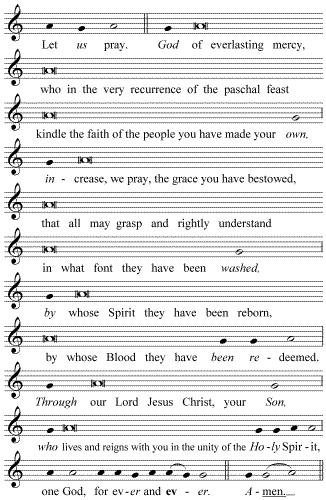

|
| Musical Musings: CNP Feedback |
|
|
CNP Feedback - O-rational ThinkingThe "Feedback Box" on the CanticaNOVA Publications website has proven quite effective in promoting communications on a variety of subjects, and expressing concerns of liturgists and musicians. From time to time, we'll compile a few of these questions or comments and put them in public view, with the hope that others with similar concerns may benefit from their content.
Q. Dear CNP:
A. Dear Poynted: The Orations of the Mass [Collect, Prayer over the Offerings, Prayer after Communion] are arranged in our newly-revised Liturgical Planning Pages to allow for singing by the priest. Take, for example, the Collect for the Second Sunday of Easter —
God of everlasting mercy, The paragraph breaks show where the two musical endings, the "Flex" and "Full Stop," might be applied. The italics, bold print and underlining indicate the method of chanting this according to the Solemn Oration Tone of the Missal (often called "pointing"). The "un-modified" text is all chanted on the "reciting tone" (second space A, in the Missal). The italics show the syllables sung on the lower note (G). The bold syllables are sung on two notes, descending (A - G). The underlined syllables are sung on two notes, ascending (G - A). The Collect, written out musically, looks like this:
This Solemn Tone can be found in Appendix I of The Roman Missal, under the heading "Tones for the Presidential Prayers." The formula for pointing the Solemn Tone is given, and for the most part, makes musical and textual sense. However, the following very strict rule: "The [ two notes before a ] Full Stop are always applied to the second to last syllable before the final accent, without respect to the accentuation of that syllable" makes for some awkward ending patterns. For example, it seems to me much more appropriate to sing: [e-ter-nal sal-va-tion] as [AGG GAA], thus moving on the accented syllable in "eternal" — rather than as [AAG GAA], as the rubric insists. However, we have on occasion thrown "artistic merit" to the wind with the pointing of these Orations in order to be faithful. All the Orations on our site follow slavishly the rubrics as set out in Appendix I. This Solemn Tone is very simple for the priest to sing — there are only two different pitches! The hardest part is to decide where to place the various changes from the reciting tone. Our CNP Liturgical Planning Pages, when coupled with the Missal tones, give priests the tools to easily sing all the Orations, thus heightening the solemnity of any Liturgy.
Gary Penkala
|
Submit Your Music / Contact Us / Company Description / Links
